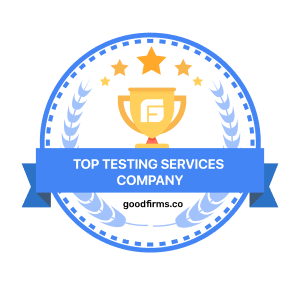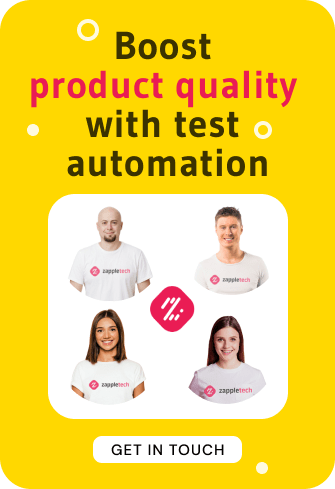Test Automation Outsourcing Services


Benefits of Test Automation Outsourcing Services
Industries We Work With
What Our Customers Say
A Full Range of Test Automation Services
- Functional testing
- Performance testing
- Cybersecurity testing
- Compatibility testing
- Localization testing
- Usability testing
- Accessibility testing
- QA consulting
- Full-cycle testing
- Test automation
- Continuous testing
- Testing in Agile
- Managed QA
- Microservices testing
- Web applications
- Mobile applications
- Cloud software
- Embedded systems
- IoT apps
- Blockchain solutions
- AI-powered applications
Your Professional Test Automation Team
Benefits Of Automated Functional Testing Service
Our Expertise

How We Work
Consider These Factors Before Outsourcing
Start Cooperation Now!

Why Should You Choose Test Automation Outsourcing?
Test outsourcing involves delegating the responsibility of designing, implementing, and executing automated test cases to an external service provider. It encompasses the transfer of QA tasks related to test automation, including the development of test scripts, execution of test cases, and analysis of test results, to a specialized third-party organization. This approach allows companies to leverage external expertise and resources to streamline their software testing processes while focusing on core business objectives.
Key Benefits of Test Automation Outsourcing
Cost-Efficiency | Outsourcing test automation can significantly reduce operational costs associated with maintaining an in-house testing infrastructure. By leveraging the resources of an external provider, organizations can avoid hefty investments in tools, technologies, and personnel required for building and maintaining a robust testing environment. |
Access to Specialized Skills | Test automation outsourcing provides access to a pool of skilled professionals with expertise in various testing tools and technologies. These specialists are well-versed in designing efficient test scripts, executing comprehensive test suites, and analyzing test results, thereby enhancing the overall quality of the software product. |
Scalability and Flexibility | Outsourcing partners offer scalability to accommodate fluctuating testing requirements based on project demands. Whether scaling up testing efforts for a large-scale project or scaling down during off-peak periods, outsourcing allows organizations to adapt quickly to changing business needs without the hassle of recruiting and training additional staff. |
Accelerated Time-to-Market | Companies can expedite the software development lifecycle by outsourcing test automation, leading to faster time-to-market. With dedicated testing teams focused on automation, repetitive tasks are streamlined, allowing developers to iterate quickly, identify defects early, and deliver high-quality software within tight deadlines. |
Factors to Consider When Selecting an Outsourcing Partner
- Domain Expertise: Look for an outsourcing partner with a proven track record in your industry vertical. Their domain knowledge will enable them to understand your unique business requirements and design tailored test automation solutions accordingly.
- Technical Proficiency: Evaluate the outsourcing firm’s technical capabilities, including their proficiency in testing tools, programming languages, and automation frameworks. Ensure they have the skills to handle your project’s technological complexities effectively.
- Communication and Collaboration: Effective communication is vital for successful outsourcing partnerships. Choose a vendor with clear communication channels and a collaborative approach to ensure alignment of goals, expectations, and project timelines.
- Quality Assurance Processes: Assess the outsourcing partner’s QA processes and methodologies to ensure they adhere to industry standards and best practices. Look for certifications such as ISO 9001 or CMMI to validate their commitment to quality excellence.
Common Misconceptions and Challenges in Test Automation Outsourcing
- Loss of Control: One common misconception is the fear of losing control over the testing process by outsourcing it. However, outsourcing partners work closely with clients to establish transparent workflows and maintain open lines of communication, ensuring that stakeholders retain visibility and control over the testing activities.
- Data Security Concerns: Security risks associated with sharing sensitive data with external vendors often deter companies from outsourcing test automation. Outsourcing partners implement robust data protection measures to address this challenge, including encryption, access controls, and compliance with industry regulations such as GDPR and HIPAA.
- Dependency on External Providers: Another concern is the dependency on external providers for critical testing functions. However, by carefully selecting reputable outsourcing partners and establishing comprehensive service level agreements (SLAs), organizations can mitigate this risk and ensure the continuity of testing operations.
- Cultural and Timezone Differences: Collaboration across geographically dispersed teams can pose challenges due to cultural differences and timezone constraints. To overcome this hurdle, outsourcing partners employ strategies such as distributed team structures, overlapping work hours, and cultural sensitivity training to foster effective communication and collaboration.
The Case for Test Automation Outsourcing
Offshoring of test automation brings into focus the most compelling way to considerably reduce the expenses of software testing that is looking to be optimized. Companies can shave off some direct overhead expenses through the relationship with third-party service providers and prudently develop and manage their testing infrastructures. Outsourcing lacks the need to make immediate funding commitments on test equipment/technological tools and hiring people specifically for the purpose, which may be more cost-effective.
On the other hand, outsourcing providers tend to operate on a pay-per-use or subscription-based fee structure, which enables companies to do just that based on the need for the project. It also offers flexibility so the firm can manage its testing capability as required, wherein scalability permits scaling up during peak periods and scaling down during off-peak periods. This leads to the effective use of testing resources, making organizations to meet their resource needs without spending excessively on the resources or infrastructure that are never put to use.
Access to Specialized Skills and Resources
Besides, raking up expertise is an attribute of test automation outsourcing. A broad resource base of specialized skills is available. Outsourcing partners utilize in-depth testers with diverse knowledge ranging from powerful testing tools to various technologies and methodologies. Through these specialists, in-depth knowledge of automation frameworks, scripting languages, and verification practices is shared, which enables test teams to design custom test suites for each project’s distinct needs.
Besides that, the external bodies usually do training, and although they bring to their teams skills and the latest trends in the industry as a whole, they also process the education of their testers. Such dedication to skills development ensures that organizations always benefit from solutions with advanced expertise and state-of-the-art tools, which usually require the ultimate effort to hire a new employee.
Accelerated Time-to-Market
Outsourced test automation can defy time in some ways. It can shorten the software development life cycle and help companies introduce products and features faster. The placement of external testing capabilities can enable organizations to advance the testing processes by effectively using test resources and thus avoid defect discoveries late in the software development life cycle. Automaton is about the speedy execution of test cases on different environments and configurations concurrently, providing developers the opportunity to upgrade quickly upon detection of any issues or bugs.
Moreover, luxury retail partners advance agile methodologies and DevOps in integrating testing into the software pipeline. Ultimate CI/CD pipelines make ready-for-use test automation possible through code commit to run production. The varying testing approach leads to quicker releases of software increments, meeting the increasing customer demands for continuous updates and enhancements in time.
Improved Software Quality and Reliability
One of the most important tasks that test automation outsourcing is responsible for is providing higher product quality and software reliability. Performing monotonous test activities by robots allows for avoiding most human mistakes. It provides robust coverage of all the tasks, from general criteria to specific functional and nonfunctional ones. Automation frameworks enable the generation of well-structured test scripts that can be rerun over and over again without the need to worry about test coverage. Consequently, it is possible to discover defects once they are still in the early development stages.
Besides, outsourcing agents use examination techniques and validation mechanisms to ensure the software applications are without functional errors, performance issues, and security flaws. Automated tests now enable organizations to detect any defects sooner; thus, they can deal with them and avoid failures in the production environments as well. Finally, the outcome is software agreed upon by the users as a reliable and resilient product fully adaptable to their needs.
Test automation outsourcing offers a compelling value proposition for organizations seeking to optimize their software testing processes. By leveraging external expertise, resources, and infrastructure, companies can achieve cost-effective, scalable, and efficient testing solutions that accelerate time-to-market and improve software quality and reliability.
Implementing Test Automation Outsourcing: Best Practices
Establishing upshot goals and expectations is mandatory to operate a good automation outsourcing plan. Organizations must formulate a statement of their testing objectives, define the key performance indicator (KPI), and plan for completion by a given deadline. Through sharp delineation of the scope of work, the anticipated outcome, and the performance threshold, the required perspective of the counterpart will be reached.
Besides, enterprises have to provide details on the automation coverage area and implementation on supported platforms and test environments to be used. Specifications and test case provisioning may enhance integration into the new project and better clarify the meaning of the requirements. The situated objectives and expectations mean a specific route map for the provider that will enable them to streamline their efforts and assist in rapidly undertaking the desired outcome of the testing task.
Establishing Effective Communication Channels
Effective communication fosters collaboration and transparency in test automation outsourcing engagements. Organizations should establish regular communication channels with their outsourcing partner to facilitate ongoing discussions, updates, and feedback exchanges. Leveraging communication tools such as video conferencing, project management software, and collaboration platforms can facilitate real-time interactions and streamline information sharing.
Moreover, organizations should designate dedicated points of contact on both sides to liaise between the client and the outsourcing team. These focal points can coordinate meetings, address queries, and escalate issues as needed, ensuring smooth communication throughout the project lifecycle. Regular status meetings, progress reports, and milestone reviews enable stakeholders to proactively stay informed about project progress and address any emerging concerns.
Collaborating Closely with the Outsourcing Partner
Collaboration is key to maximizing the value of test automation outsourcing partnerships. Organizations should foster a culture of collaboration by encouraging knowledge sharing, cross-functional teamwork, and continuous improvement initiatives. Engaging with the outsourcing partner as a strategic ally rather than a mere service provider can yield greater synergy and innovation in testing efforts.
Collaborative workshops, joint problem-solving sessions, and brainstorming exercises can help align stakeholders on testing priorities, identify potential bottlenecks, and explore opportunities for process optimization. By leveraging both parties’ collective expertise and perspectives, organizations can drive innovation, streamline workflows, and deliver higher-quality software products.
Furthermore, fostering a collaborative mindset fosters a sense of ownership and accountability among team members, leading to greater engagement and commitment to project success. By working closely with the outsourcing partner, organizations can harness their combined strengths to effectively overcome challenges, mitigate risks, and achieve shared goals.
Monitoring and Evaluating Performance
Continuous monitoring and evaluation are essential for ensuring the success and effectiveness of test automation outsourcing engagements. Organizations should establish robust performance metrics and KPIs to measure testing activities’ performance, quality, and efficiency. These metrics may include test coverage, defect detection rate, test execution time, and adherence to project timelines.
Regular performance reviews and progress assessments enable organizations to identify areas for improvement, address emerging issues, and course-correct as needed. Leveraging automation tools and dashboards can provide real-time visibility into testing metrics and trends, facilitating data-driven decision-making and performance optimization.
Moreover, organizations should conduct periodic reviews and retrospectives with the outsourcing partner to solicit feedback, discuss lessons learned, and identify opportunities for collaboration and innovation. By fostering a culture of continuous improvement, organizations can drive excellence in test automation outsourcing initiatives and deliver superior software quality to end-users.
Overcoming Challenges and Mitigating Risks
These are critical components, at least, when dealing with outsourced test automation. Organizations must understand that all proprietary code, customer data, and business processes are expected to be under the right security protection during the whole outsourcing engagement. These fears should be solved by putting in place controls and encrypted data transfers, and the outsourcing partner should collaborate as well.
This could mean implementing encryption of transmission and storage of data, as well as the implementations of access controls and authentication mechanisms, and it could also be regular security audits and security assessments. For that, it is equally important to develop explicit regulations and documentation regarding data processing, usage, and confidentiality in case personal data is accessed inappropriately or compromised.
Establishing business relationships with outsource providers that follow the set industry standards and regulatory requirements to the needed level, such as GDPR, HIPAA, and ISO 27001, to ensure their programming for data security and compliance is a simple and sure way. By resorting to data security and confidentiality, organizations can limit the risks of test automation outsourcing to proceed with personal data safely.
Managing Cultural and Timezone Differences
Diversification in culture and time difference is a common challenge that testing outsourcing ventures with team members in different locations may encounter. Communication styles, work practices, and business culture may vary, which influences the degree of collaboration and coordination among the stakeholders. In view of the above issues, organizations need to adopt ways and means for enhancing cultural sensitivity, reducing social exclusion, and addressing the gaps in cultures.
Implementing transparent communication methods with defined methods, e.g., occasional meetings via video conference and virtual collaboration tools, will help resolve cross-time zone problems. The key to better intercultural understanding and teamwork is to generate a supportive environment that is open to exchanging ideas, practicing active listening, and showing concern for each person’s culture.
Additionally, while accommodating these cultural perceptions, organizations should accommodate differing beliefs about individual responsibilities when making decisions and their preferred conflict resolution styles. The flexibility of arranging meetings, accepting different work styles and cultures, and generally keeping to the motto ‘together we are strong’ can help maintain employees’ sense of unity and belonging regarding geographical distances.
Ensuring Alignment with Organizational Goals and Values
As part of the process, closely following organizational goals and values as one key success factor should be considered. It is rather important for the lifetime of test automation outsourcing initiatives. the company should determine a potential outsource partner whose mission, which will also tell much about their values and work culture, should match or be consistent with their organizational ethos and strategic objectives. Through meeting with similar vendors, corporations can make it possible for involvement and association to reach similar objectives.
Considering the importance of transparency, honesty, and uprightness during vendor selection, the cultural compatibility and matching of the prospective outsource partners is allegedly carried out. Theoretically, deep due diligence, containing impartial references, site visits, and positive client testimonials, can give you the possibility to see the vendor’s reputation, track record, and moral responsibility.
It is also necessary for organizations to set the same expectations, objectives, and goals with clear metrics in the contracts, which would prevent the contractors from disrupting organizational objectives. Liaison with stakeholders and their feedback, plus regular use of performance reviews, should be done often to account for the attainment of objectives and to bring about course correction if necessary during the outsourcing assignment.
However, through preparations in advance to avoid security and confidentiality issues, during cultural and timezone adaptation, and finally ensuring consistency with the company’s values and goals. The company will get the maximum benefit from the activities related to test automation outsourcing. An adept risk management strategy and mitigation ways, as well as letting corporations take advantage of the benefits of outsourcing while decreasing the potential threats and challenges associated with this phenomenon.
Ultimately, a test automation outsourcing solution makes a perfect fit for business software testing programs so they can increase their efficiency, save time and cost, improve software quality assurance, and ensure software robustness. Through partnerships with external experts to get resources and infrastructures on board, organizations can obtain cost-effective, scalable, and efficient software testing options, which finally improves the software’s credibility and helps to get time-to-market slashed.
Organizations can clear the objectives and expected results through effective communication channels, and the working relationship can be developed closely even with the outsourcing partners. Risk management can be effective if the monitoring is closely held. Curating data safety solutions, cultural differences navigation, and goal alignment with the organization are key components in delivering maximum results through test automation outsourcing.
Test automation, however, entails a path that provides innovation, adaptability, and competitiveness in the context of a rapidly changing software development habitat. By applying outsourcing as a strategic tool for software QA, businesses can consistently develop better software programs that can meet market dynamics related to the changing expectations of the end-users and high quality.
Organizations should not forget to pursue the principles of transparency, trust, and partnership in outsourcing automation testing. Promoting a collaborative way of thinking, accepting the differences of cultures, and observing the shared values of the parties concerned would be such an initiative that would build relations based on enthusiasm for working together, understanding, and a sense of belonging, which lead to a strategic partnership.
In line with the test automation outsourcing journey organizations are embarking on, it is necessary to make all the outsourcing engagements happen with due care, foresightedness and a quality pledge. By sticking to best practices, being proactive while addressing challenges, and relying on the great minds of both sides, organizations can deploy automation outsourcing without any issues and deliver quality tests that keep their competitors on their toes in this day and age.
Frequently Asked Questions:
What if I am not happy with a QA engineer I hired?
Let us know about it as soon as you can. We will look into the problem and help you solve it. If this doesn’t help, we will replace this QA engineer at no cost to you. Before we start a project, you will be able to interview the candidates and select your own team.
How do I know if your software testers are perfect?
Here are a few possible ways to check our skills:
- See our case studies to learn more about the results of our work.
- Check out our clients’ reviews on Clutch. If you need additional references, let us know.
What is AQA outsourcing?
Testing strategy design, test environment setup, test case and script preparation, software testing, and defect description are all covered by AQA outsourcing.
What AQA outsourcing services do you provide?
We provide complete test automation coverage, systems and platforms and experience of our experts in automated testing.
How do I manage my team?
Instead of making you spend tons of time managing QA, we will take full responsibility for running and managing your software testing process to you. As a QA team lead, we will advise you on a team setup, and help you with workload distribution and testing strategy planning. We will make sure all test cases are implemented and your product is fully tested.
When you outsource QA engineers at Zappletech, it will feel like we’re part of your team. But unlike most in-house testing teams, we don’t require babysitting. You will only need to spend an hour or so per month to review our current progress and the results of our efforts. We build transparent communication with clear reports and regular team calls. We’re always online ready to respond to any questions you might have.
What if I need a large team, can you help with that too?
Yes, we can. Currently, we have 55 full-time quality assurance specialists. But we also own the largest online QA community in our country. If our resources aren’t enough, we will be able to quickly find needed people from our community.
What is the main reason to automate QA?
Automated software testing can assist enhance software quality by increasing the depth and scope of tests. Unattended testing can be used to execute lengthy tests that are generally avoided during manual testing. They can even be installed on several computers with various settings.








